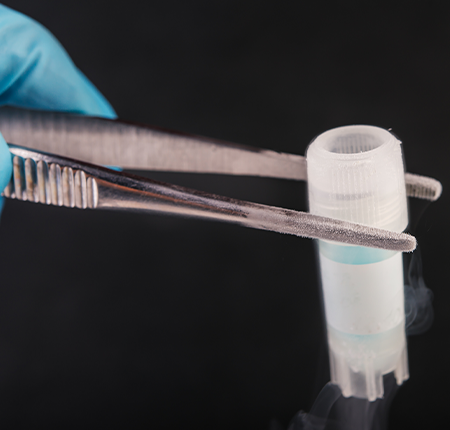
The spermogram is the only official method accepted by the World Health Organization (WHO) for the analysis of male fertility. This analyzes the concentration, structure and mobility of the seminal fluid.
It's basically the only accepted way for a couple who can't get pregnant to find out if semen is the reason, and why. However, abnormal results are not a permanent verdict of infertility – they can indicate a temporary condition or problem, so a spermogram can be a first step towards treating it and improving your fertility.
There are other circumstances in which the doctor may recommend a spermogram, such as after a vasectomy or vasectomy reversal. Read the article and find out everything every man should know about the spermogram and how to prepare for collection.
What is a spermogram?
Spermogram, or sperm analysis, is a test that measures the characteristics of sperm and sperm – both quantitatively and qualitatively. The result of a spermogram reflects the quality of the seminal fluid, the number of spermatozoa, but also their ability to fertilize.
Although the spermogram is also known as the "male fertility test", because it can indeed detect if spermatozoa are completely absent and therefore the man is infertile, the abnormal results obtained from the test do not automatically mean infertility. But I can confirm that sperm is part of the reason the couple can't get pregnant.
When is spermogram recommended?
In principle, the spermogram is recommended for couples who have tried and failed to get pregnant after repeated unprotected sex for a year. In these situations, the spermogram can provide an answer about the quality of the sperm and the possibility that it is part of the cause.
The result can mean infertility, but not only - it can indicate a low number of sperm in the seminal fluid, their absence, the structure or viscosity of the fluid, but also an infection or other temporary problem that can be treated and does not affect long-term fertility .
Some of the most common situations in which a spermogram is recommended are:
To determine if the man is suffering from infertility
After a vasectomy, to assess its effectiveness
After a vasectomy reversal, to assess its effectiveness
To establish a diagnosis of hematospermia (when blood is present in the semen)
To determine the possible effects of mumps on spermatogenic tissue and varicocele on spermatogenesis
Preparation for harvesting
In order to perform the sperm analysis, it must first be collected. The collection process is not difficult, but there are certain preparations and recommendations that the man must take into account so that the result of the spermogram is as accurate as possible:
It is usually recommended to repeat the spermogram 2-3 times in the following weeks. The quality of semen can vary from day to day, and repeating the analysis can provide the most accurate results.

risks
There are no risks associated with the spermogram, and the sperm sample collection procedure does not involve discomfort or other known risks.
If for various reasons masturbation is a problematic action for a man, an alternative collection method can be established together with the doctor.
Interpretation of results
Semen analysis involves a lot of measurements that describe the seminal fluid and the sperm. Thus, the results will be interpreted according to the following criteria:
Volume
Normal values are between 2 and 5 ml after an ejaculation. If the volume is smaller, it is called hypospermia or microspermia and can be caused by a chronic inflammation of the prostate and seminal vesicles. If sperm is totally absent, it is called aspermia.Color
A white, opaque, slightly yellowish color is considered normal.pH
Normal sperm pH parameters are between 7.12 and 8. A lower pH can be the result of genital inflammation and can negatively affect sperm movement.Liquefaction time
Normally, the liquefaction time should be less than 30 minutes. Semen has a more viscous texture immediately after ejaculation to prevent the free movement of sperm. This viscosity is lost as special enzymes break down the colloidal substances and the semen liquefies and releases the sperm. If the liquefaction process lasts more than 30 minutes, it may signal an inflammation of the genital tract.Concentration
Normal values are over 20 million sperm per milliliter, which means a minimum of 40 million sperm after an ejaculation. A lower concentration is called oligozoospermia which, although it does not automatically mean infertility, may be associated with an increased likelihood of infertility depending on the severity. The total absence of sperm, or azoospermia, is instead a sign of infertility and occurs when both testicles are affected.Form
Normal sperm structure includes a rounded head shape and a straight, long, thin tail.Motilal
Normal sperm movement is fast, in a straight line, and is due to tails with undulating movements. There are 4 types of movement, namely type a (rapid movements of the tail and side movements of the head), type b (only movements of the tail, not the head), type c (no movement, only movements in place by vibrations strong) and type c (no movement – spermatozoa are immobile and often confused with dead spermatozoa).
Spermogram - Costs
The cost of a spermogram differs depending on the laboratory where the collection is done, but also on the techniques used. Among the most well-known analysis techniques are CASA (Computer Assisted Semen Analysis), Leucoscreen and rapid tests. Prices start from approximately 100 lei.
The difference between spermogram and sperm culture
Both spermogram and sperm culture are two types of sperm analysis, but their purpose is different.
The purpose of the spermogram is to analyze the characteristics related to the structure, mobility and quantity of spermatozoa and seminal fluid.
Sperm culture is intended to identify bacteria or other pathogens present in the semen to determine if there is an infection in the urinary tract that may be causing infertility.
What does infertility mean?
Infertility is defined as the inability to get pregnant after a period of one year in which the couple has tried repeatedly through unprotected sex to conceive a baby. The diagnosis is made after testing both partners, through:
Genetic tests, hormone tests, spermograms and biopsies in men.
Ovulation testing, hysterosalpingography, ovarian reserve testing and other hormone tests and imaging investigations in women.
Infertility can often be a result of spermatic disorders (sperm production dysfunction) in men, or problems with ovulation in women.

About 17.5% of the adult population faces infertility, according to a recent study published by the World Health Organization. Experts estimate that:
What happens if the spermogram shows normal values?
If the spermogram shows normal values, it means that the analyzed values are within the parameters and no abnormalities have been detected to indicate that the infertility is caused by problems with the seminal fluid.
In this situation, further investigations can be carried out to determine the cause, including for the partner.
Spermogram is not the only method of testing a man's fertility, and the doctor can recommend several additional investigations such as blood tests, imaging tests (eg: testicular ultrasound, transrectal ultrasound to evaluate the prostate), but also hormonal analyses, genetic tests or testicular biopsy .
How does sperm count affect fertility?
Low sperm count in the semen is a common factor why couples experience fertility problems.
It does not necessarily mean that the man is infertile, and a pregnancy can be achieved even if the spermogram indicates oligozoospermia. But the lower the sperm count and the more severe the oligozoospermia, the higher the risk that the partner will not get pregnant.
Possible treatments
If the spermogram result reflects a low sperm count or another sperm problem, the doctor will investigate the cause and, depending on it, recommend the following treatment options:
Surgery: surgery is recommended, for example, to correct varicocele, that is, when the veins draining blood from the testicles dilate. It is one of the most common disorders that cause male infertility.
Antibiotics: if there is an infection in the genital or urinary tract; treating this infection unfortunately does not always restore fertility.
Medicines or counselling: when problems during intercourse, such as erectile dysfunction or premature ejaculation, prevent you from getting pregnant.
Hormonal treatments: if the underlying cause of infertility is a hormonal imbalance
When should a fertility specialist be consulted?
Before you panic and call a fertility specialist, consider that it can take anywhere from 6 months to a year of repeated attempts for a woman to get pregnant. This is perfectly normal, and not a cause for concern if the partners do not suffer from fertility problems.
A woman's body is most fertile - meaning she has the best chance of getting pregnant - in the 5 days before ovulation, at ovulation and the day after. Basically, there are 7 days a month when the chances of pregnancy are higher, and they decrease significantly if you have unprotected sex on the other days. If you want to read more about what it means and how to track the fertile period, I explained everything to you in the article HERE .
And age is an important factor influencing fertility. Therefore, the most common situations in which consultation with a fertility specialist is recommended are:
If the partner is under 35 years old, you have repeated unprotected sexual contacts during fertile periods and you fail to get pregnant in a period of more than 1 year.
If your partner is over 35 years old and you have been trying to conceive for over 6 months.
The specialist can later recommend infertility tests (for both partners), appropriate treatments depending on the results or various planning methods such as the calendar method .
How is infertility treated?
The treatment for infertility depends on the cause, which is detected following the analyzes carried out by both partners at the doctor's recommendation. In some cases, treatment is necessary for only one partner. Other times, both partners need treatment to increase fertility and the chances of getting pregnant.

Fortunately, being infertile is not the same as being sterile, meaning the possibility of conceiving is non-existent. Among couples facing infertility, only 1-2% suffer from infertility according to statistics. And thanks to medical advances, most couples (over 50%) who seek specialist help manage to have children following the treatments:
Men may be recommended surgery for varicocele or fluidization of sperm passage. Women may be recommended surgery to remove the blockage in the fallopian tube.
It is the most effective assisted reproductive procedure and involves the artificial fertilization, in the laboratory, of oocytes extracted from the mother's body. They are collected from the ovaries under anesthesia and are fertilized with sperm collected from the partner or a donor. Embryos obtained from fertilization are selected and transferred to the uterus to achieve a pregnancy.
It is another assisted reproductive procedure in which a single sperm is transferred into the cytoplasm (the main body of the egg) when the woman is at her peak fertility. The procedure is recommended when the couple's infertility is caused by the man's diagnosis, respectively in severe cases where the number of spermatozoa in the semen is very low.
In-vitro fertilization and artificial insemination are the most effective and used assisted human reproduction technologies. Artificial insemination, or intrauterine, involves the transfer of spermatozoa directly into the uterus so that they are as close as possible to the egg, and the chances of fertilization increase. Unlike the in-vitro procedure, the egg is fertilized naturally in the fallopian tubes following artificial insemination.






















